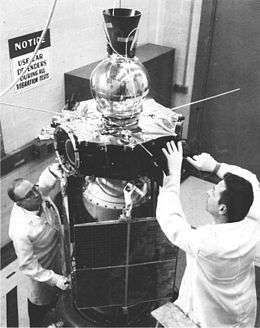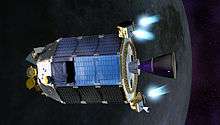Explorer 35
 | |
| Mission type | Space physics |
|---|---|
| Operator | NASA |
| COSPAR ID | 1967-070A |
| SATCAT № | 2884 |
| Mission duration | 2,167 days |
| Spacecraft properties | |
| Manufacturer | Langley Research Center |
| Launch mass | 104.3 kilograms (230 lb) |
| Start of mission | |
| Launch date | July 19, 1967, 14:19:02 UTC |
| Rocket | Delta E1 |
| Launch site | Cape Canaveral LC-17B |
| End of mission | |
| Disposal | Deactivated |
| Deactivated | June 24, 1973 |
| Decay date | Mid-late 1970s |
| Orbital parameters | |
| Reference system | Selenocentric |
| Semi-major axis | 7,886 kilometers (4,900 mi) |
| Eccentricity | 0.0136973 |
| Periselene | 764 kilometers (475 mi) |
| Aposelene | 7,886 kilometers (4,900 mi) |
| Inclination | 147.3 degrees |
| Period | 710 minutes |
| RAAN | 90.2825 degrees |
| Argument of periselene | 39.3155 degrees |
| Mean anomaly | 321.7298 degrees |
| Mean motion | 14.95777010 |
| Epoch | 03 March 1969 11:06:06 UTC |
| Revolution number | 16777 |
| Lunar orbiter | |
| Orbital insertion | July 21, 1967 |
Explorer 35 was a spin-stabilized spacecraft instrumented for interplanetary studies, at lunar distances, of the interplanetary plasma, magnetic field, energetic particles, and solar X rays. It was launched into an elliptical lunar orbit. The spin axis direction was nearly perpendicular to the ecliptic plane, and the spin rate was 25.6 rpm. Mission objectives were achieved. After successful operation for 6 years, the spacecraft was turned off on June 24, 1973.
Science instruments
Magnetometers
The Ames magnetometer experiment consisted of a boom-mounted triaxial fluxgate magnetometer and an electronics package. The sensors were orthogonally mounted, with one sensor oriented along the spin axis of the spacecraft. A motor interchanged a sensor in the spin plane with the sensor along the spin axis every 24 hours, allowing inflight calibration. The instrument package included a circuit for demodulating the outputs from the sensors in the spin plane. The noise threshold was about 0.2 nT . The instrument had three ranges covering plus or minus 20, 60, and 200 nT full scale for each vector component. The digitization accuracy for each range was 1% of the entire range covered. The magnetic field vector was measured instantaneously, and the instrument range was changed after each measurement. A period of 2.05 seconds elapsed between adjacent measurements and a period of 6.14 s elapsed between measurements using the same range. The instrument performance was normal.
The experiment consisted of a boom-mounted triaxial fluxgate magnetometer. Each sensor had dual ranges of minus to plus 24 nT and 64 nT, with digitization resolutions of minus to plus 0.094 nT and 0.25 nT, respectively. Zero level drift was checked by periodic reorientation of the sensors until May 20, 1969, when the flipper mechanism failed. Past this point, data analysis was more difficult as the zero level drift of the sensor parallel to the spacecraft spin axis was not readily determined. Spacecraft interference was less than 0.125 nT. One vector measurement was obtained each 5.12 s. The bandpass of the magnetometer was 0 to 5 Hz, with a 20-dB per decade decrease for higher frequencies. Except for the flipper failure, the experiment functioned normally from launch to spacecraft turnoff (June 24, 1973).
Bistatic Radar Observations
The purpose of this experiment was to study the electromagnetic reflective properties of the lunar surface. The 136.10-MHz (2.2 m) telemetry transmissions from the spacecraft were scattered from the lunar surface and then recorded by use of the 150-ft Stanford dish antenna. The reflected signal intensity depended upon the lunar reflectivity, the spacecraft altitude above the lunar surface, and the mean curvature of the Moon. The returned signal bandwidth was proportional to RMS lunar surface slopes. Occultation phenomena permitted a determination of the scattering properties of the lunar limb. The dielectric constant of the lunar subsurface in the scattering region below a depth of about 25 cm was then determined from a profile of reflectivity values vs the angle of incidence on the Moon. The mean lunar slope over each area from which signals were reflected has also been inferred. The observations were located within about 10 degrees of the lunar equator. Experiment operation was normal as of March 1971.
Ion chambers and Geiger tubes
This experiment consisted of a 12-cm Neher-type ionization chamber and two Lionel type 205 HT Geiger-Müller (GM) tubes. The ion chamber responded omnidirectionally to electrons above 0.7 MeV and protons above 12 MeV. Both GM tubes were mounted parallel to the spacecraft spin axis. GM tube 1 detected electrons above 45 keV that were scattered off a gold foil. The acceptance cone for these electrons had a 70-deg full-angle and an axis of symmetry that was 20 deg off the spacecraft spin axis. GM tube 2 responded to electrons and protons above 22 and 300 keV, respectively, in an acceptance cone of 70-deg full-angle centered at the spacecraft spin axis. Both GM tubes responded omnidirectionally to electrons and protons of energies above 2.5 and 50 MeV, respectively. Pulses from the ion chamber and counts from each GM tube were accumulated for 39.72 s and read out every 40.96 s. In addition, the time between the first ion chamber pulses in an accumulation period was also telemetered. This experiment performed well initially.
Micrometeoroid detector
This experiment was designed to measure the ionization, momentum, speed, and direction of micrometeorites, using thin film charged detectors, induction devices, and microphones.
Faraday cup
A multigrid, split-collector Faraday cup mounted on the equator of the spacecraft was used to study the directional intensity of solar wind positive ions and electrons with particular emphasis on the interaction of the solar wind with the Moon. Twenty-seven integral current samples (requiring about 4.3 s) were taken in an energy-per-charge window from 80 to 2850 eV. Then the current was sampled in eight differential energy-per-charge windows between 50 and 5400 eV at the azimuth where the peak current appeared in the previous series of integral measurements. These measurements (integral and differential) took about 25 s. Both the sum and difference of collector currents were obtained for positive ions. Only the sum was obtained for electrons. A complete set of measurements (two collector plate sums and one difference for protons, and one collector plate sum for electrons) required 328 s. The experiment worked well from launch until its failure in July 1968.

